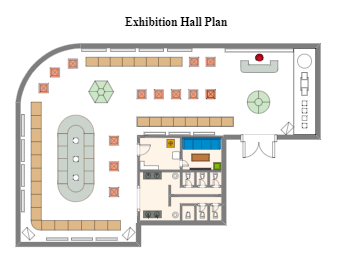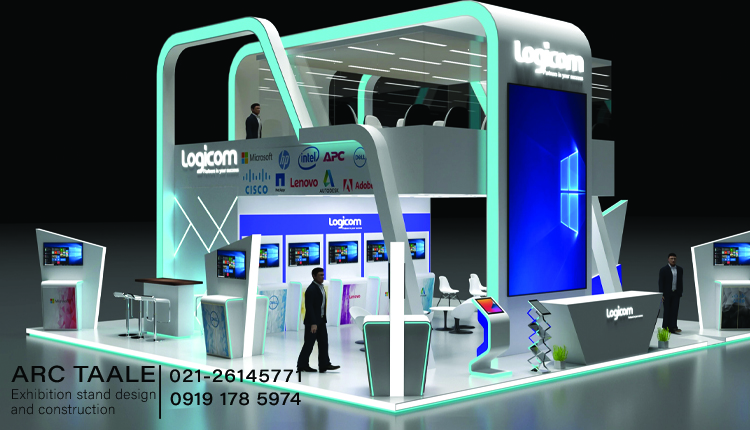In the realm of exhibitions, the layout serves as the canvas upon which the narrative unfolds, the stage where artifacts come to life, and the conduit through which visitors embark on a transformative journey. Crafting an exhibition layout is a meticulous endeavor that requires equal parts artistry, strategy, and ingenuity. It is the foundation upon which the entire exhibition experience is built, shaping the way visitors perceive, interact with, and ultimately, remember the exhibition.
What to Consider when Designing an Exhibition Layout?
Embarking on the journey of designing an exhibition layout is akin to weaving a tapestry that tells a compelling story. Every element, from the placement of artifacts to the use of space and lighting, contributes to the overall narrative. In this meticulous process, various considerations come into play, ensuring that the exhibition layout not only engages visitors but also conveys the intended message with clarity and impact.
Define the Theme
The first step in exhibition design is to clearly define the theme. Whether it’s a historical retrospective, an exploration of cultural diversity, or a showcase of technological innovation, a well-defined theme acts as the guiding thread that ties the entire exhibition together.
Understand the Audience
Consideration must be given to the target audience. Understanding their demographics, interests, and knowledge levels allows designers to create an immersive experience that resonates with visitors on a personal level. This consideration ensures that the exhibition is accessible and engaging to a diverse audience.
Create a Flow
The layout should facilitate a natural flow, guiding visitors through a carefully curated journey. Whether chronological, thematic, or narrative, a well-designed flow ensures that each exhibit complements the next, creating a cohesive narrative that captures the attention and interest of the audience.
Optimize Space
Space is a valuable commodity in exhibition design. Efficiently using available space not only accommodates the exhibits but also determines the comfort and accessibility for visitors. Striking a balance between visual impact and maneuverability is crucial for a successful exhibition layout.
Consider Lighting and Ambiance
Lighting plays a pivotal role in exhibition design. Thoughtfully illuminating exhibits can enhance the visual appeal, create focal points, and evoke specific moods. Balancing natural and artificial light sources contributes to the overall ambiance, enhancing the visitor’s experience.
read more
Interactive Elements
Integrating interactive elements adds a dynamic layer to the exhibition. Hands-on displays, multimedia installations, or augmented reality experiences not only captivate visitors but also foster a deeper connection with the content. These elements can transform passive observers into active participants.
Consider Accessibility
Accessibility is a key consideration in exhibition design. Ensuring that the layout accommodates visitors with diverse abilities, incorporating ramps, clear signage, and tactile elements, guarantees an inclusive experience for everyone.
Incorporate Technology
Embracing technology can elevate the exhibition experience. From interactive touchscreens to virtual reality, incorporating cutting-edge technology adds a contemporary touch and enhances the overall engagement for a tech-savvy audience.
Pay Attention to Details
The devil is in the details, and exhibition design is no exception. Attention to small details, such as font size, color schemes, and material choices, contributes to the overall aesthetic appeal and cohesiveness of the exhibition.
Test and Iterate
Before the grand unveiling, it’s crucial to test the exhibition layout. Soliciting feedback, observing visitor behavior, and making necessary adjustments ensure that the final presentation is not just visually appealing but also effectively communicates the intended message.
What is an Exhibition Layout?
In the realm of exhibition design, each decision holds the potential to transform a space into a captivating journey. From the initial theme definition to the final touch-ups, every step in the process contributes to the creation of an immersive and unforgettable experience for visitors. By considering these aspects, designers can craft exhibition layouts that not only showcase artifacts but also tell stories that resonate and linger in the minds of those who walk through the curated space.
An exhibition layout is the meticulously planned and thoughtfully crafted arrangement of displays, artifacts, and interactive elements within a designated space. Far more than a mere spatial arrangement, it is the deliberate orchestration of visual elements, narrative flow, and sensory experiences that collectively tell a compelling story. In the realm of museums, galleries, trade shows, and cultural institutions, an exhibition layout serves as the canvas upon which narratives come to life, captivating audiences and creating immersive journeys through time, culture, or thematic exploration.
what’s the best use of the Exhibition space?
The exhibition space, a blank canvas awaiting transformation, holds the potential to captivate, educate, and inspire. The key to unlocking its full potential lies in strategic and thoughtful design, ensuring that every square foot contributes meaningfully to the overall narrative. From the choice of exhibition layout to the placement of exhibits, the best use of exhibition space requires a delicate balance of creativity, functionality, and visitor engagement.
Define Purpose and Message
Before embarking on the design journey, it’s crucial to define the purpose of the exhibition. Whether aiming to educate, entertain, or provoke thought, a clear understanding of the message guides decisions on space allocation, ensuring that each area serves a specific purpose in conveying the intended narrative.
Create Zones for Varied Experiences
Dividing the exhibition space into distinct zones allows for a diverse range of experiences. Whether it’s an immersive storytelling corner, a hands-on interactive area, or a contemplative space for reflection, carefully designed zones cater to the varied interests and preferences of visitors, enhancing their overall experience.
Consider Flow and Movement
The best exhibition spaces are like a well-choreographed dance, guiding visitors through a seamless journey. Carefully planned pathways, clear sightlines, and thoughtful transitions ensure that guests can navigate the space effortlessly, enhancing their engagement with each exhibit in a logical and intuitive sequence.
Prioritize Focal Point
Strategic placement of focal points within the exhibition layout space is essential to capture visitors’ attention. Whether it’s a standout artifact, a visually stunning display, or a multimedia showcase, focal points serve as anchors, guiding visitors and creating memorable moments within the overall narrative.
Optimize Vertical Space
Effective exhibition design extends beyond the horizontal plane. Utilizing vertical space through hanging installations, towering displays, or elevated platforms adds a dynamic dimension to the space. This not only maximizes visual impact but also creates a layered and immersive experience for visitors.
Flexibility for Evolving Exhibits
An optimal exhibition space is one that can adapt to changing exhibits and themes. Incorporating flexible design elements, such as modular walls, movable partitions, and adaptable lighting schemes, ensures that the space remains versatile and can accommodate a diverse range of displays over time.
Balance Openness and Intimacy
Finding the equilibrium between open, communal spaces and intimate, secluded corners is essential. While open areas encourage social interaction and group engagement, intimate spaces allow for personal reflection and a deeper connection with specific exhibition layout, catering to the diverse preferences of visitors.
Integrate Technology Thoughtfully
In the digital age, technology is a powerful tool for enhancing exhibition spaces. Thoughtfully integrating multimedia displays, interactive touchscreens, and virtual elements contributes to a contemporary and engaging experience, provided they align seamlessly with the exhibition’s overall message and theme.
In the realm of exhibition design, the art lies in orchestrating a symphony of space that resonates with visitors on multiple levels. By purposefully allocating space, considering the flow and movement, and incorporating elements that enhance engagement, designers can unlock the full potential of an exhibition space. The result is an immersive and memorable experience that transcends the physical confines of the space, leaving a lasting impact on all who traverse its carefully curated landscape.


